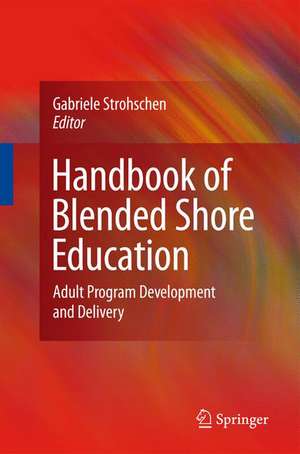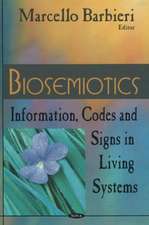Handbook of Blended Shore Education: Adult Program Development and Delivery
Editat de Gabriele Strohschenen Limba Engleză Hardback – 13 noi 2008
| Toate formatele și edițiile | Preț | Express |
|---|---|---|
| Paperback (1) | 644.49 lei 43-57 zile | |
| Springer Us – 28 oct 2010 | 644.49 lei 43-57 zile | |
| Hardback (1) | 650.86 lei 43-57 zile | |
| Springer Us – 13 noi 2008 | 650.86 lei 43-57 zile |
Preț: 650.86 lei
Preț vechi: 765.72 lei
-15% Nou
Puncte Express: 976
Preț estimativ în valută:
124.56€ • 129.70$ • 105.27£
124.56€ • 129.70$ • 105.27£
Carte tipărită la comandă
Livrare economică 10-24 martie
Preluare comenzi: 021 569.72.76
Specificații
ISBN-13: 9780387094427
ISBN-10: 0387094423
Pagini: 345
Ilustrații: XXXII, 346 p.
Dimensiuni: 156 x 235 x 22 mm
Greutate: 0.71 kg
Ediția:2009
Editura: Springer Us
Colecția Springer
Locul publicării:New York, NY, United States
ISBN-10: 0387094423
Pagini: 345
Ilustrații: XXXII, 346 p.
Dimensiuni: 156 x 235 x 22 mm
Greutate: 0.71 kg
Ediția:2009
Editura: Springer Us
Colecția Springer
Locul publicării:New York, NY, United States
Public țintă
Professional/practitionerDescriere
As we confront the future of our professional endeavors, we tend to rely with con?dence on longstanding and widely honored assumptions about the world and ourselves. We believe we have accumulated sturdy structures of knowledge, eff- tive practices, and sound values. Yet, we rely on these resources with scant c- sciousness that in the long run our assumptions, practices, and values may not only be inimical to the viability of our profession, but as well, oppressive in their effects on others. There is at least one assumption – common across many professions and cultures – that is of particular signi?cance. It is the assumption that the world is made up of discrete entities or units. There are not only the species of plants and animals, for example, but there is me as opposed to you, us vs. them, my business enterprise in competition with yours, our nation or religion and yours. And with this assumption of separable units, we assemble ways of sustaining and protecting those units of which we feel a part. We erect buildings, laws, schools, governments, and armies to ensure that what is inside the boundary will ?ourish, and what is outside cannot threaten us. In effect, the assumption of a world of independent entities establishes the way in which we understand and conduct ourselves within relationships.
Cuprins
The Introduction and Pillar Chapters.- Interdependence: Inescapable Reality or Utopia?.- Understanding Development.- Lifelong Learning—An “Economistic” Discourse Umbrella for an Old Phenomenon?.- ISO and the International Standardization of Adult Education.- The Spiritual Aspects of an International Adult Education Program.- The Thematic Sets.- Valuing Science and Science Learning as Scientific Capital.- Higher Education Health Program at Airlangga University.- Factors to be Considered in Delivering Programs Across Nations and Cultures.- Engagement in Active Learning with Brazilian Adult Educators.- Celebrating the Local.- Developing Leaders While Sustaining Values.- Remembering for the Future.- Community Learning Centers in Vietnam.- Education for Healthcare Waste Management in India.- Managing Chinese International Rotation Programs to Benefit Your Own Company Rather than Competitors.- Universities, Government and Industry in Knowledge, Skill and Innovative Capacity Diffusion of Thailand’s Automotive Cluster.- The Best-Laid Plans.- Distance Education, National Development, and Globalization.- A Case for the Internationalization of Adult Education Curricula in Graduate Programs.- Videoconferencing as a Tool for Bringing International Experts into the Classroom.- Blended Shore Programs: The Vision and Reality of 21st Century Adult Education.
Textul de pe ultima copertă
The delivery of adult education programs has developed into an industry with global players in education and corporate institutions. Education is increasingly becoming a commodity exported to emerging economies by "first world" institutions. With the thirst for such blended shore programs by these consumers, there is a danger of malpractice if educators do not mindfully and critically examine their practice and learn through reflection and analysis. While maintaining a commitment to adult education as a means to educate, train and develop leaders for social sustainability, the impact of these educational practices also needs to be examined.
In the Handbook of Blended Shore Education, educators and trainers critically examine their experience with blended shore programming and derive recommendations for good practices from such reflection and analysis. A group of internationally renowned authors raise vital questions about the export of education as a commodity wherein education maintains a purely instrumental value. It introduces an interdependent "next level" in blended shore education that can be achieved when the partner countries reach a transformation point where both benefit from examined values and the time and costs invested in the program. With that, this important book proffers a paradigm of good practices for blended shore programs that goes beyond delineating so-termed best practices.
Sound adult education principles and models of adult education are presented as a means for sustainable social and economic development. Sharing the lessons learned about program design and delivery with candid narrations about the design, development, and delivery of such programs, and narrated by authentic voices in the field, authors from around the world contribute to the emerging knowledge base of international (or blended shore) adult education. This is a knowledge base that acknowledges the value of indigenous wisdoms, the importance of individual performance improvement, and the inextricability of international education based on interdependence and collaborative education program design and delivery.
The recommendations support a professional practice of international adult education that is clearly rooted in an examined praxis, and are useful for program planners, practitioners, and chief learning officers in public and private education endeavors from the grass roots to the boardroom. With a backdrop of non-formal education; higher education; corporate training; workforce development; and basic education program settings, the Handbook of Blended Shore Education, examines what worked and what didn't work and brings the lessons learned to today's program administrators, CLOs, trainers, teachers, and community workers.
In the Handbook of Blended Shore Education, educators and trainers critically examine their experience with blended shore programming and derive recommendations for good practices from such reflection and analysis. A group of internationally renowned authors raise vital questions about the export of education as a commodity wherein education maintains a purely instrumental value. It introduces an interdependent "next level" in blended shore education that can be achieved when the partner countries reach a transformation point where both benefit from examined values and the time and costs invested in the program. With that, this important book proffers a paradigm of good practices for blended shore programs that goes beyond delineating so-termed best practices.
Sound adult education principles and models of adult education are presented as a means for sustainable social and economic development. Sharing the lessons learned about program design and delivery with candid narrations about the design, development, and delivery of such programs, and narrated by authentic voices in the field, authors from around the world contribute to the emerging knowledge base of international (or blended shore) adult education. This is a knowledge base that acknowledges the value of indigenous wisdoms, the importance of individual performance improvement, and the inextricability of international education based on interdependence and collaborative education program design and delivery.
The recommendations support a professional practice of international adult education that is clearly rooted in an examined praxis, and are useful for program planners, practitioners, and chief learning officers in public and private education endeavors from the grass roots to the boardroom. With a backdrop of non-formal education; higher education; corporate training; workforce development; and basic education program settings, the Handbook of Blended Shore Education, examines what worked and what didn't work and brings the lessons learned to today's program administrators, CLOs, trainers, teachers, and community workers.
Caracteristici
Presents accessible experiences as examples for the principles of the text
Details principles and techniques from diverse program structures to craft appropriate practices for a wide variety of individual settings
Introduces the concept that interdependence is necessary for a socially sustainable education praxis and examines the notions around education as a commodity and motifs for exporting education programs as commodities
Offers specific strategies and tools for all phases of design and delivery of international adult education
Details principles and techniques from diverse program structures to craft appropriate practices for a wide variety of individual settings
Introduces the concept that interdependence is necessary for a socially sustainable education praxis and examines the notions around education as a commodity and motifs for exporting education programs as commodities
Offers specific strategies and tools for all phases of design and delivery of international adult education





